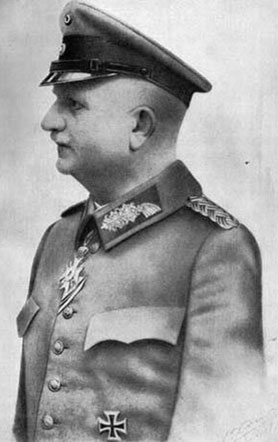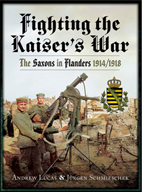On Sunday 25th April 1915 the Second Battle of Ypres was in full swing. On the XXVII. Reservekorps front 53. Reserve-Division launched local attacks near Broodseinde to hold the British in place.

West of Passchendaele the corps reserves (including Regiment von Heygendorff) continued the drive against the northern face of the salient, which had begun with a major gas attack on the previous day. While the battle continued to rage, Generalmajor Richard Kaden (brigade commander of the mixed Saxon / Württemberg 58. Infanterie-Division) found himself at a loose end. With his troops held in OHL (supreme command) reserve in the Roubaix area since the end of March and no prospect of deployment, Kaden went on a leisurely Sunday drive as far as the XXVII.RK rear area:
I visited the grave of Achim Peter in Ledeghem, and found it handsomely cared for and located in a tranquil spot in the churchyard. I contemplated the young life which had met its end here, then drove to Roulers where I spent a most diverting hour, since a huge crowd of captured Canadians had just arrived in the marketplace via the narrow-gauge railway. They all looked very much the worse for wear. The eight officers who marched at the head of the group made a reasonable impression. At the marketplace I met the staff officer of the division, my old friend from the Kriegsakademie General von Runckel [Kdr. of 43. Res. Div.]. I briefly visited him and heard some details of the fighting which is still raging north-east of Ypres, in which von Watzdorf's Saxon division [53. Res. Div.] was also involved. When the trenches were stormed many of the enemy were captured in an insensible condition, poisoned by the gas, together with many others who gave themselves up without any resistance...
On the return journey I broke down a short distance from Courtrai. In the village in question [Lendelede] there is a Saxon Etappenfuhrparkkolonne [rear-area supply park column] under the command of Graf Schimmelmann, where I spent an hour or so. Just eight days ago the famed aviator Ltn. Garros was captured here. Flying his machine-gun armed craft alone without an observer, he had shortly before brought down a German Taube and then proceeded to drop a bomb on the railway station. To this end he had descended to a height of 600 metres, and was at that very moment spotted by men of the Landsturm, shot at and forced into a steep glide. Immediately after landing he had burned his machine and concealed himself in a ditch, where he was discovered. The French papers are greatly mourning the loss of this man, the best of their aviators, who had also made a most favourable and gentlemanly impression on Schimmelmann.

- Prev
- Next >>





